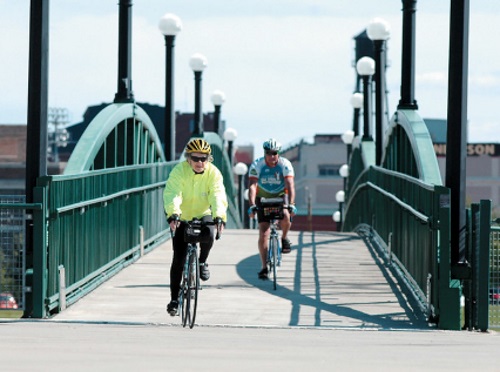May is “National Bike Month” and many state departments of transportation across the country are working to raise awareness regarding use of the bicycle as a work commute and daily travel mode of mobility.
[Above photo by the Ohio DOT]
“Long rides across town, an adventure on a favorite trail, or a quick trip around the block are many ways to celebrate and enjoy National Bike Month,” noted Joseph Giulietti, commissioner of the Connecticut Department of Transportation, in a statement.

“Cycling can be fun, good for a person’s health, and is a sustainable and green mode of transportation,” he said.
Connecticut DOT stressed in its public outreach that combining bicycling with other modes of public transportation helps extend the range of travel, especially for those using bicycles to commute to work.
For example, all CTtransit buses are equipped with bike racks, while most of the state’s passenger trains permit riders to travel with their bicycles.
[Editor’s note: The American Association of State Highway and Transportation Officials and Michael Baker International hosted a bike infrastructure tour of San Diego during the AASHTO 2021 annual meeting – the latest in a series of events designed to educate and encourage transportation officials to advocate for biking and pedestrian facilities in their hometowns.]
Meanwhile, Barb Chamberlain – director of the active transportation division at the Washington State Department of Transportation – shared a blog post full of “Bike Month” safety advice.

“The bicycle is a healthy, convenient, affordable, enjoyable and environmentally sound form of transportation,” she said. “Bicycles also serve as essential transportation for many who do not or cannot drive, allowing them to access jobs, education, essential goods and services, transit, and community life.”
Many state DOTs are also ramping up effort to develop statewide bike route networks. For example, in July 2021, the Ohio Department of Transportation unveiled a bicycling and pedestrian “framework” to advance statewide development of active transportation over the next five years.
The agency said its new Walk.Bike.Ohio plan – constructed over a two-year period based on input from local governments, other state agencies, and the public – seeks to improve mobility, safety, and quality of life as part of “equitable investments” statewide in walking and bicycling infrastructure, maintenance, programs, and policies.
Concurrently, in February 2021, AASHTO and the Adventure Cycling Association formalized a nearly 17-partnership to establish a nationwide 50,000-mile network of bike routes.
“This highlights AASHTO’s long-standing commitment to advancing a multimodal vision for America,” noted Jim Tymon, executive director of AASHTO, said in a statement at the time. “Each new bike route gives people more travel options to connect with neighboring communities, recreational facilities, and tourism.”
 Top Stories
Top Stories
USDOT Makes $1.5B Worth of BUILD Grants Available
December 19, 2025 Top Stories
Top Stories

